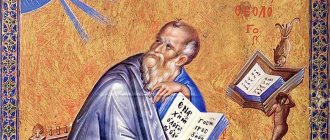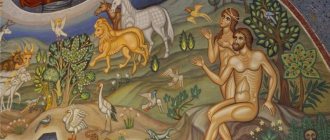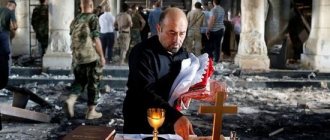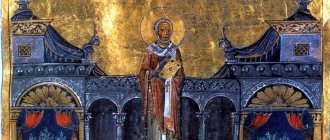Article one
The revelation of Jesus Christ, which God gave Him to show His servants what must soon happen.
The apocalypse is such a revelation of hidden secrets, which occurs during insights of the mind or in visions during sleep, or in the waking state with the help of Divine illumination. If the apostle says that this Revelation was given to Christ from God, then he uses the expression in relation to human nature, for in his Gospel he, more than all other evangelists, depicts Him in sublime features and Divine expressions. Also here, through the serving angel and in the name of the disciples, he points out to us the greatness of the Divinity of Christ, for all things work for Him (Ps. 119:91).
The expression of being soon means that some of what was predicted in Revelation is, so to speak, at hand, and those related to the end will not be slow to be fulfilled, for with the Lord a thousand years are like yesterday, and those who have passed by (Ps. 89:5; 2 Pet. 3, 8).
And He showed it by sending it through His angel to His servant John, who testified the word of God and the testimony of Jesus Christ, and what he saw.
Christ, as Master, showed this to me through an angel, to me, His servant, who testified to his confession, so that through what I saw I would testify and preach for the conversion of those listening both about what, although it exists, is hidden from people, and about what what has to be. For the seer prophetically << saw both; This is also clear from the words that are and should be, indicating the present and future tense.
Blessed is he who reads and hears the words of this prophecy, and keeps what is written in it: for the time is at hand.
Glorifies those who read and listen in order to fulfill, because the time appointed for people to do and receive bliss is short. “Work while it is day and night will come, when no one can work,” says the Lord (John 9:4). Otherwise: in comparison of this short-term life with the future, eternal life, the time of reward for everyone’s deeds is near (Matthew 17:27).
John to the seven churches that are in Asia: Grace to you and peace from Him who is, and was, and is to come, and from the seven spirits that are before His throne, and from Jesus Christ.
Although there were many local churches, he sent only seven churches. He did this for the sake of the septenary number, which mysteriously means all the churches, and also because of the correspondence of this number to real life, in which the septenary circle of days is accepted. For the same reason, he mentions only seven angels and seven churches, to whom he sends his greeting: “grace to you and peace from the Trinitarian Divinity.” The word He is the Father who said to Moses: I am He (Ex. 3:14); the same expression as 6e - the Word, which at the beginning of 6e is to God (John l, l); in a word, he who is coming is the Comforter, always descending on the believing children of the Church in holy baptism and having to be poured out on them in all its fullness in the next century (Acts 2). By seven spirits one can understand the seven angels (who received control of the churches), not placed together with the God-originating and Royal Trinity, but remembered with Her as her servants, as the divine Apostle says in the same way: I will testify before the Gods and Lords Jesus Christ and the elect His angels (1 Tim. 5:21). But this can also be understood in another sense: by the expression Saa, who is 6e, and who is to come, we mean the Father, Who contains in Himself the beginning, the middle and the end of the existence of everything that exists; under the seven spirits are the gifts of the Life-giving Spirit; who then follows - Jesus Christ, God, who became Man for us. For even in the Apostle the Divine Persons are placed before and after without any distinction, therefore here he also speaks from Jesus Christ, etc.
Who is the faithful witness, the firstborn from the dead and the ruler of the kings of the earth.
For He, who testified before Pontius Pilate, is faithful in all His words (Ps. 144:13), like life and resurrection; He is the firstborn from the dead (Col. 1:18; l Cor. 15:20), and over whom He rules, they will not see death, like those who died and were resurrected before, but will live forever. He is the Lord of kings, as the King of kings and Lord of lords (Ps. 2:6; Col. 2:10; 1 Tim. 5:16), equal in power to the Father and Consubstantial with Him (John 10:30; 14:20). Otherwise: He is the King of kings of the earth, kings over earthly passions. And if blessed Gregory the Theologian refers to Christ the expression Sya, and the 6th, and the one who is to come, the Almighty, THEN it would not be in the least inappropriate to attribute the following sayings to Him. To these words the Almighty is added and no other person is mentioned. This meaning of the above is confirmed by further words: and from Jesus Christ, because if only one God the Word and the Son's Hypostasis were spoken of, then it would be completely unnecessary to use words in from Jesus Christ to separate Him from another. Divine words befit equally both each individual Hypostasis and all together, with the exception, perhaps, according to Gregory the Theologian, of the differences and properties that are special and personal, and those related to the incarnation of God the Word. This is also confirmed by the fact that we are taught in the Gospel to relate the Trisagion of the Seraphim to the Son, in Acts, in the sermon of the Apostle Paul - to the Holy Spirit, and in the offering of the Holy Mysteries - to the Father, to whom we address this prayer, as he says about this Blessed Epiphanius in his sermon on the Holy Spirit. We present all this as evidence that our explanation does not contradict the opinion of the church fathers, and now, with God’s help, we will move on to the next one.
To Him, who loved us and washed us from our sins with His Blood, and made us kings and priests to His God and Father, be glory and power forever and ever, Amen.
It befits, he says, glory to Him, who, out of His love, freed us from the bonds of mortality and washed us with the outpouring of His Life-giving Blood and water from the filth of sin and made us a royal priesthood, offering the Father a living sacrifice - verbal service instead of the victims of dumb animals.
Behold, He comes with the clouds, and every eye will see Him, even those who pierced Him; and all the families of the earth will mourn over Him. Hey, amen.
Here He, slain as a lamb, will come in the glory of the Father as the Judge, on clouds, or incorporeal forces, or similar to the cloud that overshadowed Him with the apostles on Mount Tabor. Every eye will see Him coming with His glory; His crucifiers and the tribes of the earth who do not believe in Him will mourn (Matthew 24:29-30). Hey, amen means: absolutely, yes. These words mean the same thing in both Greek and Hebrew. Amen - let it be.
I am Alpha and Omega, the beginning and the end, says the Lord, who is, and who was, and who is to come, the Almighty.
The words Alpha and Omega signify Christ as God, containing everything, beginningless and infinite: He is, and was before, and has no end, co-essential with the Father, and therefore having to reward everyone according to his deeds.
I John, your brother and partner in the tribulation and in the kingdom and in the patience of Jesus Christ, was on the island called Patmos for the word of God and for the testimony of Jesus Christ.
I, as your brother and accomplice in the sorrows of Christ for the sake of Christ, have fully earned your trust, for, condemned for the confession of Christ on the island of Patmos, I proclaim the mysteries that I saw on it.
Antichrist and the end of the world
Perhaps the most mysterious image that we see in this book is the Antichrist. He appears in the form of two animals. The first of them comes out of the sea and acts rudely, with direct persecution. The other comes out of the ground and causes harm more subtly, through seduction and cunning.
The Antichrist will come at the end of time to compete with Christ for the eternal fate of human souls
The eschatological approach is expressed in drawing parallels between the Roman Empire and the sinful world. Rome begins to literally eat itself, choking in the streams of sin and sinful pleasures. John the Theologian warns through his book that such a death awaits the whole world as a whole.
Article two
A vision in which I saw the Clothed One in the midst of seven golden lamps
I was in the spirit on Sunday and heard behind me a loud voice, like a trumpet, which said: I am Alpha and Omega, the First and the Last; write what you see in a book and send it to the churches that are in Asia: to Ephesus and Smyrna, and to Pergamum, and to Thyatira, and to Sardis, and to Philadelphia, and to Laodicea.
Embraced by the Holy Spirit and receiving spiritual hearing, I heard on the most revered Sunday day the voice of the Lord, like a trumpet in its sonority, for their message went out into all the earth (Ps. 18:5). Pointing with the words Alpha and Omega to God’s beginninglessness and infinity, He commanded me to tell the seven churches about what I had seen, denoting the number seven, ending on Saturday, the Sabbath, that is, the rest of the century of the future. Therefore, writes the great Irenaeus, God created seven heavens and seven angels who rule over others.
Preface to the modern edition
The pious reader is invited to publish the exegetical treatise “Interpretation of the Apocalypse of the Holy Apostle and Evangelist John the Theologian” by St. Andrew, Archbishop of Caesarea in Cappadocia, who lived at the end of the 6th – beginning of the 7th centuries. This work presumably dates back to the first two decades of the 7th century.[1] Nothing more about St. himself. We do not know Andrei, since church sources did not preserve any information about him. St. Andrew, mentioning Jerusalem, however, says nothing about its capture by the enemies of the Byzantine Empire - the Persians in 614 to 627 and the Arabs in 638. Consequently, the work is supposed to have been written either before 614, or between 627–638[2].
Few church authors were fully involved in the interpretation of the Apocalypse. In the Christian East - Origen, blessed. Icumenius, St. Andrew of Caesarea, Arephas of Caesarea, as well as individual authors who explained certain passages from this book, which results in the relative paucity of these comments. Some commentaries are also found in the Latin West by such authors as St. Victorinus of Petavsky, Tikhonius, St. Caesarea of Arelate, Bede the Venerable, etc. This is largely due to the fact that church writers and exegetes, out of humility, did not feel worthy to interpret this most mysterious and enigmatic book of the New Testament, which contains the highest eschatological prophetic visions of future events preceding the end of the world: about the Coming of Christ, about the destinies of the Church and the individual, the Resurrection, the Last Judgment and the Kingdom of the next century. For all this was revealed in part by the Lord Jesus Christ Himself in the Gospels, and also by the Holy Spirit to the Apostles. At the same time, much is presented in mysterious images and symbols, and for its interpretation it requires the same spiritual prophetic gift. “When a person studies the New Testament and begins Revelation, he feels transported to another world. This book is not at all like the other books of the New Testament. Revelation is not only different from other New Testament books, it is also extremely difficult for modern people to understand and therefore it has often been ignored...”[3] Therefore, in his preface, St. Andrei reports that he begins to explain this book not of his own free will, but at the long requests of his friends and flock. It is also worth noting that not everything that is found in the Revelation of St. John, St. Andrey interprets unambiguously and clearly. Regarding some eschatological subjects, he offers different interpretations, and also admits to his blissful ignorance regarding them, otherwise he would have to become a “second John the Theologian” or equal to him.
“The interpretation of the Apocalypse of Andrew of Caesarea is generally accepted for the Byzantine tradition. Its importance lies not only in its historical significance, but also in the fact that Andrew uses the commentary of Ikumenius, the first Greek commentator on the entire text of the Apocalypse.
The work of St. Andrew is divided into 24 words and 72 chapters, which contains a certain numerical symbolism. Revelation mentions 24 elders, the number of which is multiplied by 3 - in accordance with the tripartite structure of the meanings of Holy Scripture[5]: “body”, “soul” and “spirit”, introduced into the Christian theory of biblical hermeneutics by Origen in the 3rd century and reflecting three the main meanings of Holy Scripture - literal, moral and dogmatic (or mystical). The structure of the “Interpretation” consists of a sequential, verse by verse, presentation of the text of the Apocalypse and the following comments to them by St. Andrey.
St. When interpreting, Andrew of Caesarea also resorts to the comments of previous exegetes of the Apocalypse: Blessed. Ikumenius, Bishop of Trikki in Thrace - who, according to some assumptions, lived in the 6th century (whom, however, he does not call by name), Papias of Hierapolis (70-155), St. Justin the Philosopher and Martyr (120–166), St. Irenaeus of Lyons († 202), St. Hippolytus of Rome († 258), St. Methodius of Patara († 312). In addition, he turns to other holy fathers: St. Gregory the Theologian, St. Epiphanius of Cyprus, St. Cyril of Alexandria, St. Dionysius the Areopagite and some others.
“Interpretation of the Apocalypse of the Holy Apostle and Evangelist John the Theologian” by St. Andrew, Archbishop of Caesarea of Cappadocia, spread and became very popular in different countries. Based on it, Arethas, the archbishop of Caesarea in Cappadocia, wrote his interpretation of the Apocalypse in the 9th century. In the 10th and 11th centuries, the interpretation of St. Andrei's work was translated into Georgian, Armenian and Slavic languages. “In the middle of the 13th century, the text was rewritten by the Novgorod scribe sexton Timofey” [6] and became widespread in Rus'. In the 17th century, a translation into Russian was made by Lavrentiy Zizaniy and was republished in the 18th century. The translation into the more familiar modern Russian language was made in the 19th century by M. S. Bogolyubsky and V. M. Yuryev.
The text of the “Interpretation” in the book offered to the reader is published based on the translation by V. M. Yuryev (M., 1911), who himself checked his translation with the previous translation by M. S. Bogolyubsky (M., 1882). In addition, for our publication we used the book “Interpretation of the Apocalypse of St. Andrew, Archbishop of Caesarea” published by the Athos Russian St. Panteleimon Monastery (M., 1901; reprint: Joseph-Volokolamsk Monastery, 1992). In addition, the editor provided the text with indications of the pages (columns) of the edition of the Greek and Latin texts of the “Interpretation” in the 106th volume of J. P. Min’s “Patrology” and in places checked the translation text with the Greek original. Also, whenever possible, quotations from various holy fathers of the Church found in the text of St. Andrey[7]; indications of them are given in the notes at the end of the book, among other notes (mainly of a historical nature), helping the reader to better understand the text of St. Andrey. The very text of the Book of Revelation of St. John the Theologian, as well as all New Testament quotations, for accessibility to the widest range of modern readers, are given not in Church Slavonic, but in Russian according to the Synodal translation. Quotations from the Old Testament are given in places in Church Slavonic, in places in Russian.
In addition, the editors found it possible to replace some outdated expressions and words of the Interpretation with new ones that are more understandable and familiar to a wide range of readers.
The editors hope that this book will become for domestic readers a source of knowledge of the spiritual light of Christ's truth, and also very relevant in the context of special modern interest in eschatological topics.
P. K. Dobrotsvetov
Preface to the 1911 edition
Interpretation of St. Andrew of Caesarea is the oldest extant interpretation of the Apocalypse of St. John the Theologian, this only prophetic book of the New Testament.
About the life of St. Andrew, Archbishop of Caesarea in Cappadocia, there is disagreement among church historians; more likely, however, is on the side of those who attribute his life and work to the 5th–6th centuries.
The Greek text of the interpretation is placed in the Patrology of Min (PG. T. 106. Col. 207–486).
St. Andrew finds a triple meaning in the Apocalypse: literal or historical, allegorical and anagogical; he considers the latter to be the most important.
The main task of his interpretation comes down to indicating in history the fulfillment of the prophecies contained in the Apocalypse, and he admits that such an indication is only partly possible, because much of what is said in the Apocalypse still belongs to the future.
Interpretation of St. Andrew serves as the main paternal interpretation of the Apocalypse, because all subsequent paternal interpretations of this book are extracted from it with the addition of some new explanations (for example, from Arethas, Archbishop of Caesarea, an outstanding writer of the Byzantine era).
We checked our translation with the best translation of the interpretation, which belongs to Archpriest M. S. Bogolyubsky (in editions of 1882 and 1902).
Yuri Nikitin - Revelation
Introductory fragmentsf_heroic Yuri Nikitin Revelation Sir Thomas Malton of Gisland, a valiant knight, was not particularly reserved and once said in his hearts that on his wedding day someone appeared in charred armor and dragged his bride... to hell. Do you think Sir Thomas was separated from his beloved forever, because not every mortal can find the way straight to the underworld? No matter how it is! His friend, Oleg, seems to have been to those places before...
ru ru CarBit FB Tools 2004-12-14 A1359A42-A5A0-444E-ABC1-80B5EF7E199F 1.0 Revelation EKSMO 2003 5-04-009163-X Yuri Nikitin Revelation Publisher: EKSMO, 2003 Hardcover, 480 pp. ISBN 5-04 -009163-X Circulation: 7100 copies. Format: 84×108/32
Yuri Nikitin.
Revelation.
* PART ONE *
Chapter 1
Trees were being hastily cut down in the nearby forest. It smelled of fresh herbs and tree sap. Livestock was driven from the villages, and butchered carcasses were transported on wide carts. In the courtyard of the royal castle, axes clacked all night, the breeze blew openwork rings of pine shavings. By the light of the fires, carpenters were building a spacious platform for noble knights. Barrels of the oldest and most expensive wine were rolled out from the cellars of the royal castle ahead of time. The valiant knight Sir Thomas Malton was in a hurry to celebrate the wedding.
Two days ago, at a military gathering, the knights proclaimed him king. And although the oldest and most experienced suggested holding the coronation ceremony first, and only then getting married, Thomas was adamant.
His bride, a proud and strong woman from the northern lands, who had gone with him on a long and dangerous journey, had already settled into a kingdom that was strange to her, managing the palace servants as if they were her own servants. And the knights learned to pronounce her name in full, respectfully interpreting its meaning.
Guests for the wedding of the young king, although not yet crowned, began to arrive on the third day after his victory over the demons of Stonehenge. Krizana, the former bride, after some hesitation, did not stay for the wedding, to Thomas’s great relief. An honorary guard of hired soldiers under the command of the old knight Makogon departed with her.
Father and uncle Edwin did not sleep at night, stunned, happy, preparing both the wedding and the future coronation, and worried about the lands that now fell into the hands of the last of the Malton family, who not only returned alive, but also managed to obtain a shrine from the ruins of burning Jerusalem Christianity - the Grail, bring to Britain...
The wedding was prepared by the old knight MacDonald, a great expert in heraldry, the customs of royal courts, and the chief steward of large hunts. Severe and tireless even at his age, he could stay in the saddle for days, fight in the front rows, at feasts he drank and ate for three, and if he avoided anything, it was perhaps pickles, because his head could not fit into a barrel, but If I did get through, it really stung my eyes. Now he stopped the young warriors, squires, and instructed strictly, but in a fatherly way:
- During the ceremony, place the sword on the knee of your right hand... Bend your fingers at the elbow, there should be delight and adoration on your face, there is a king in front of you... Hey, squire, don’t make a smart face, you are still a brave knight in the future! And you two, why are you sleeping while standing on the move?.. Chest forward, don’t slouch! At your age, I had already worn my feet up to my ass with my boots, and you trudge from step to step for like three days... Think about the future! And now what interests you more, what I, MacDonald from the Macdonald clan, am telling you, or that dead pigeon that flies over the yard?.. Just like that, broader shoulders... Now it’s clear that well done. With such boys, future knights, our beautiful ladies can sleep peacefully.
And at the other end of the corridor, Uncle Edwin hurriedly instructed the servants:
- Okay, you don’t have to wash the floors every day, but at least every day!.. This is not a pigsty, now this is the king’s ancestral castle... Who said that the geese should be served on the table later, after the pigs have been eaten? A goose is no problem for a pig. Hey, who's walking around there with a red nose like a cucumber? You get drunk and crawl around on all fours, as if the wedding is already in full swing!..
By noon, guests began to arrive. The servants dismantled the horses, and the guests were led into rooms where they could shake off the dust and even wash themselves.
Old Macdonald invited Thomas to put on royal armor: covered with gold, with luxurious designs, decorated by the best craftsmen in Britain. Thomas glanced at the gilded armor with incredible contempt:
- These?.. Thin sheets of metal that I can pierce with my finger?
“This is dress armor,” MacDonald explained significantly. “They don’t fight in them, but deign to appear to the common people.” Fools fall for anything shiny. That’s why we have no price for such armor! How do they shine on me? And it’s easier to feast in the front rooms...
Thomas shook his head adamantly.
“In my heavy armor I can run after a horse, jump over a spear and a set table. I won't embarrass myself with this rubbish. Besides, even though the king was not a child, this will not fit on me.
MacDonald looked at the young knight with respectful eyes. The last of the Malton family was tall, shoulder-width, with arms as long as oars and thick as logs. The chest looks as if it was already wearing armor under a knitted knight's shirt. A daring face, fire in the eyes, strength and impatience in every word and gesture. If such people remained in Britain, they would smash it to pieces. Fortunately, wise heads, saving the peace of the country, came up with a crusade to distant countries, where almost all the heroes laid down their heads...
“As you say, my king,” he said, calling Thomas king for the first time, although the coronation was scheduled for a week later, when bishops and envoys from neighboring kingdoms would arrive. “But a king can get married without any armor at all.”
Thomas muttered with displeasure:
“Without armor, I’m like naked.” We slept there, in the sands of Saracinia, in armor... otherwise we would not have survived. Okay, we'll think of something.
By evening, the doors of the main royal hall, more like a gate, opened before the guests. The huge room shone, Thomas ordered all the weapons in the royal collection to be hung on the walls, and two carts of candles as thick as one-year-old piglets were brought from the nearest monastery. Now they were burning brightly and cheerfully, reflected on shiny blades, wide blades of swords, axes, on greaves, expensive helmets, on gilded and silvered armor.











